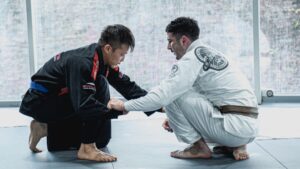Stepping onto a Jiu-Jitsu mat for the first time brings a mix of nerves and excitement. One of the concepts that often confuses newer students is how to flow roll. It gets mentioned all the time in class, usually with encouraging reminders about how valuable it is, yet it rarely gets explained in a way that truly makes sense. Many students assume it simply means rolling lightly, but flow rolling is much more about connection, trust, and awareness than about reducing intensity.
When done correctly, a flow roll feels smooth and almost rhythmic. Movements blend together, transitions feel natural, and the exchange becomes a form of communication rather than a battle. Understanding how to do this well can completely change how training feels and how quickly skills develop.
TL;DR
-
Flow rolling is a cooperative, smooth style of training that focuses on movement and transitions instead of winning.
-
It works best when both partners match each other’s pace and let go of ego or resistance.
-
Regular flow rolling builds timing, awareness, creativity, and overall technical growth in Jiu-Jitsu.
Understanding the Heart of Flow Rolling
Flow rolling is essentially a cooperative way to move through positions without the intention of dominating your partner. This is where many new practitioners get stuck. Even when the roll is supposed to be light, the instinct to resist a sweep or squeeze a grip can slip in. Flow rolling works only when both people allow movement to continue without shutting down the exchange.
Instead of reacting with tension, the goal is to respond with awareness. A smooth flow roll feels like two people sharing the same rhythm. If your partner transitions, you follow that motion and offer your own in return. Submissions appear and fade without pressure. Everything keeps moving, almost like a conversation happening through body language rather than words.
Letting Go of the Competitive Mindset
One of the hardest parts of learning to flow roll is letting go of the urge to win every exchange. Even in a relaxed roll, it is easy to slip into a defensive mindset the moment a partner starts to pass or secure a dominant position. That little jolt of panic breaks the flow.
Once the focus shifts from winning to learning, flow rolling becomes far easier to understand. The moment a partner reaches mount or lands a sweep becomes an opportunity to explore rather than a mistake that needs correcting. When the pressure to prove something fades, movement becomes more fluid and curiosity naturally takes over. This is when creativity starts to grow on the mat.
Matching the Energy of Your Partner
A truly good flow roll depends heavily on both partners matching each other’s pace. If one person moves slowly and thoughtfully while the other suddenly bursts into fast transitions, the rhythm breaks down. Flow rolling has a very specific feel and both people need to share the same intention for it to work.
It helps to start at a gentle pace and adjust gradually. A quick word before the roll can make a huge difference. Something as simple as agreeing to keep things light or playful sets the tone and helps both participants understand the level of intensity to use. Once both partners find the same pace, the movement becomes far smoother and much more enjoyable.

Paying Attention to Transitions Instead of Holding Positions
A key part of flow rolling is focusing on the movement between positions rather than trying to freeze the action in place. Instead of pinning someone in side control or clamping down in mount, the goal is to see how the position develops. The transition becomes the main point of interest.
This approach builds a deeper awareness of timing, balance, and subtle pressure. Mistakes become more obvious. Small imbalances reveal themselves. Flow rolling highlights these details gently, without the rush and tension of a competitive roll. Over time, these insights translate into better reactions and cleaner technique in sparring.
Treating Submissions as Gentle Checkpoints
Submissions during a flow roll should feel like light suggestions rather than forceful attempts to finish. They appear naturally during the movement and then get released once they are recognized. The tap is rarely needed because the pressure is never pushed to a dangerous point.
Using submissions in this gentle way teaches recognition instead of aggression. It helps practitioners understand the moment a submission becomes available and how to move through it calmly. These small glimpses of opportunity often become fully usable skills later during more intense training.
How Flow Rolling Elevates Your Overall Game
Practitioners who make flow rolling a regular part of their training tend to notice that their entire Jiu-Jitsu game becomes smoother. Movements feel less forced. Breathing stays more relaxed. Positions and escapes begin to feel instinctive instead of rushed. The body learns to respond with calm efficiency rather than panic.
A flow roll also encourages experimentation. A student can try a guard pass, see what happens, adjust it, and try again, all within the same round. The lack of pressure opens the door to creativity, and this environment often speeds up technical growth more than hard rounds alone.
Developing the Art of Flow Rolling
Flow rolling can feel strange at first, especially for anyone who is still learning the basics of Brazilian Jiu-Jitsu. With time, patience, and a willingness to let go of the urge to control every movement, it becomes one of the most rewarding parts of training.
When approached with openness and curiosity, flow rolling turns each round into a shared learning experience. It teaches awareness, timing, cooperation, and trust. Most importantly, it brings out the parts of Jiu-Jitsu that make the art feel alive. Through steady practice, the flow roll becomes not only a method for improving technique but also a way to enjoy the journey on the mats even more.


